With all the new labels everywhere boasting “organic” and the increasing variety of organic foods in the produce department, it’s worth a little time to research what and why? At first glance, I was turned away from organic produce simply based on price. I understand the reasoning behind the higher prices, but still, it’s way out of my price range to buy all organic.
It didn’t take much research to find out that some foods are at a lower risk of pesticide absorption than others. Things that have to be peeled before eaten, for example. I’ll probably never buy organic oranges or bananas. I have to peel those so any pesticide contamination should remain in the top layers of the peel.
It should also be noted, that pregnant women should consider going organic if they use a lot of any foods from the high risk category.
But what about things that do not have protective skin? How susceptible are they to higher levels of today’s mass pesticide use, and worse, contaminated fertilizer with lovely gems such as E.Coli and Salmonella. Yummy. I want to just chomp down on carrot right now.
According to WebMD, there are a few foods that should have a second look at buying organic. They call this list the Dirty Dozen.
Peaches– one of the “dirty dozen”. Their tender skin soak in pesticides.
Apples– if you can’t buy organic, WASH THESE!!
Sweet bell peppers– a recent study found that these had 49 different pesticide residues. Gross
Strawberries and cherries– high in Vitamin C and Steamin’ Stew of Pesticides.
Pears and Nectarines– USDA Pesticide Data Program found 30 different pesticide residues.
Grapes– Very susceptible to pesticides
Spinach and Lettuce– The major risk to these is not just pesticides, but contaminated manure/fertilizer. Anybody remember the salad bar scares? Yeah, poo is good for the garden, but not poo from a sick cow.
Potatoes and carrots– These are the two most popular vegetables. Kids love snacking on carrots, so make sure they’re not licking poison off of them.
Milk– ecombinant bovine growth hormone (rBGH). Make friends with this term and research your milk! According to this article, many conventional store brands do NOT supply milk from cows treated with rBGH. Check your store and call the manufacturer.
Beef- We’ve all heard of the horrors of the slaughterhouse. I’ll just leave it at that. Take out a second mortgage if you eat a lot of beef.
Peanut Butter– Organic peanut butter is just peanuts and salt. Some brands, like my favorite Maranatha, do not have salt. Choosing organic PB is less about pesticides and more about making sure the PB is free from trans fats, added oils and sugars. Kids tend to eat a lot of PB so it makes sense to make sure it’s just what you want—peanuts!
Last and probably most important—baby food. Although today’s brands of baby food undergo stringent standards, some feel that growing babies need the purest foods possible.
And I know what some of you are thinking…(imagine twangy southern accent) ‘I’ve been eating plain ol’ taters and carrots for years and ain’t nothing wrong with me.” Well, yes and no. Yes, we’ve all been eating produce with pesticides for years. However, the pesticides keep getting stronger as the pests get more resilient. Also, with the recent uses of hormones and antibiotics in our animal farms, we really have no way of knowing the long-term effects of fertilizer from these animals.
So, there you have it! If you’re concerned about what you’re putting in your body, and want to start small, try some of these. Big changes come in small steps.


The 2014 Dirty Dozen
Sunday 25th of May 2014
[…] few years ago, I wrote a post talking about the current “Dirty Dozen” which is the top 12 fruits and vegetables with the most pesticide residue. A lot of people have an […]